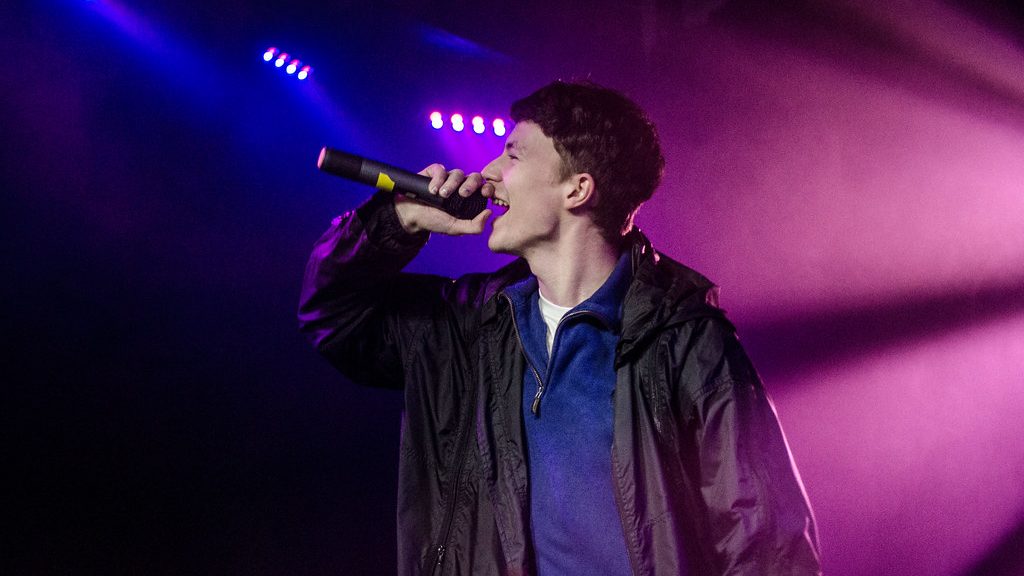Bladee’s music is either airy transcendence – kitsch done perfect – or the worst thing you’ve ever heard. Autotuned, breathy rapping over cloudy, mellow instrumentals tends to incite this kind of polarisation. His newest album 333 brings the stellar production of long-time collaborator Whitearmor together with Bladee’s unusual, off-kilter vocals under a happier, optimistic, and spiritually-tinged banner. The 16-song, 37 minute LP is thus a sincere, unexpected yet familiar shift in direction from an artist at times derided as the apotheosis of vapid, shallow Soundcloud emo-trap.
Fans of Drain Gang (a Sweden-based collective also featuring musician/fashion designer Ecco2k, rapper Thaiboy Digital, and producers Whitearmor and Yung Sherman) have long been attuned to Bladee’s fascinating, fragmented, distinctly postmodern universe. His earliest recognition occurred adjacent to that of the ironic, nostalgic cloud rap of fellow Stockholmer Yung Lean; debut album Gluee (2014) is not unfairly summed up by the frequent comments on his Instagram mourning the “old Bladee rapping about magic and swords and shit that doesn’t exist”. If his initial persona bordered on goofy, his movement to a darker, somewhat melodramatic sound on Eversince (2016) and Red Light (2018) was panned by some for being difficult to take seriously. Certain motifs emerge across his songs, whether channelled into hypnotic escapism or depressive humour: a self-hating consumerism, dreams, abortive romances, loneliness, ascension, garbage, the seduction of mind-numbing drugs. Even without buying fully into the mythos imposed by fans, these various discernible recurring themes enrich the emotions at the forefront of his music, all within imaginative spaces he constructs (a fictitious ‘Rainworld’, the heavens, hypercapitalist shopping malls).
333 explores a number of sounds, from more minimalist, indie-folk on the first track, hyper-pop (à la PC Music), and even glitch hop on the album’s first half, without a significant departure from his frigid, more ethereal soundscape. Elsewhere, the drum breaks and synths are familiar, trap-like when Bladee breaks into chorus. Even a glance at the colourful, child-like album art (designed for the first time not by Bladee, but by London artist and designer Claire Barrow) confirms the album’s nature, as a dizzying, colourful array of sounds, pop culture references, and haphazard influences; some symbols remain esoteric, yet are mobilized towards a heartfelt affirmation of the self and the seeking of internal peace and love. Nevertheless, the art remains collage-like and abstract, as per previous albums.
The opening track, acoustic-heavy ballad ‘Wings in Motion’, evokes gentle movement and growth: “ripples broken, wings in motion”, repeats Bladee over a twinkling, swelling instrumental. Religious icons come into focus on the second track ‘Don’t Worry’ (“Two white doves, mix my blood with your blood”) and these are cleverly mixed with rap clichés on later songs (“Out the gate, like Messiah/Crown around my head in barbed wire”). This interplay between lofty references and mundane, bare bodily existence is continued from earlier albums.
Elsewhere, Bladee’s vocals are noticeably different from Eversince and Red Light, in which the autotune had been dialled up to 11, for a robotic subordination to frigid instrumentals. Here, he brims with a certain confidence (unfounded, for some), giving his voice space even as the characteristic autotune remains. At times, his singing caricatures the saccharine pop of the early 2000s, a direction birthed out of collaborations with Hannah Diamond and hinted at in past singles (“In the back of the club with the bad girls/the mean girls, the bad girls”). Bladee’s cheekily experimental attitude towards gender personas is refreshing, even catchy. He hits a vocal range long-time listeners might be surprised by on ‘It Girl’, exploring the gendered paradoxes of success and power (“In this world, you gotta work to be an It Girl/Are you down to let it go? we can do it/8 hours in the dark, I’m in the Rainworld…”).
Some moments also fall flat. Over beautifully layered synths he breathlessly speaks of “endlessly reflecting in your gaze/drop the mirror and it breaks/seven years, seven tears, seven different heavens”, but the backing vocals on ‘Noblest Strive’ are less of the choir Bladee hopes for and more reminiscent of the 4am-in-the-bedroom, weird-guy persona he both embraces and transcends. ‘Oh Well’, a mantra to keep moving forward, is another song which moves from ‘great’ to ‘good’ on account of his clumsy adlibbing (‘unh, unh’, he almost moans in his second verse), in spite of the sublime production and hopeful message. Nevertheless, part of the album’s charm lies precisely in this bizarre, even jarring juxtaposition between the heartfelt confession of Bladee’s lyrics and the semi-ironic plasticity of his delivery. A few other tracks hence deserve mention: the wave-like, high-pitched trap of ‘Reality Surf’, the repetition on ‘Extasia’, the slurred vocals on medieval-sounding penultimate track ‘Only One’.
333 might best be understood as another chapter in Bladee’s exploration of emotions, moving away from a jouissance in sarcastic nihilism and towards more positive, upbeat themes of acceptance – a kind of renewal and ego death. Love him or hate him, the strange allure of Bladee remains.
(Image rights: https://www.flickr.com/photos/thecomeupshow/25403804704 image by Drew Yorke courtesy of The Come Up Show, image cropped from original)



